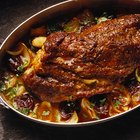grafvision/iStock/GettyImages
Curing and smoking add rich flavors to almost any kind of meat, fish or poultry, but pork stands on its own as the world champion of cured meats. Prepared smoked meats such as ham and bacon are radically different from ribs or pulled pork prepared on your backyard smoker, but they're all delicious. They also have similar food safety requirements, so keeping and reheating leftover smoked pork is the same whether it's homemade or factory-produced.
Keeping It Safe
Smoking your own pork is a chancy business, with cooking time for individual pork shoulders varying by as much as two or three hours. You can keep home-cooked or store-bought pork safely until mealtime at temperatures of 145 degrees Fahrenheit or higher, but once you're finished eating it's time to cool things down in a hurry. Spread sliced or shredded pork thinly so it cools more quickly, and cut large pieces into smaller, flatter portions. As soon as the pork reaches room temperature, get it packaged and into your refrigerator or freezer. To ensure food safety it should be at room temperature for two hours or less and down to 40 F or less within another two hours.
Refrigerating Smoked Pork
Leftover home-smoked pulled pork is the same as leftover ham or other cooked meats. According to the US Department of Agriculture's food safety guidelines, the safe storage life of these cooked meats is 3 to 4 days in the refrigerator. That assumes that the pork is stored in food-safe bags or sealed airtight containers and that your refrigerator maintains a stable temperature that's below 40 degrees Fahrenheit. Keep your meats in the back of the fridge where it's coldest and they'll be less affected by opening and closing the door. If you want to store your pork for longer than a few days, it should be frozen instead.
Freezing Smoked Pork
Smoked pork will keep for six to eight months in your freezer without its safety being affected, but its quality will vary depending how well you've packaged it. You should extract as much air as possible from the packaging, which is why vacuum food sealers work so well. If you don't have a food sealer, use heavy-duty freezer bags and squeeze out as much air as possible. Freeze the pork in thin, flat portions, which freeze and thaw readily. This helps preserve the flavor and moisture of your pork.
Thawing and Reheating
The best way to thaw your frozen pork is overnight in the refrigerator, though immersing it in cold water will also work. Like any other leftovers, thawed or refrigerated pork must be reheated to a temperature of 165 F to be food-safe. Small amounts can be simmered on the stovetop in broth or in enough of their original sauce to cover the pork and keep it from drying out. Alternatively, wrap the pork in foil with a small amount of liquid for moisture and heat it in a gentle oven at 250 F until it reaches the target temperature. Microwave ovens heat the pork unevenly, so if you reheat in the microwave, be sure to stir frequently and let the meal rest so the heat can even itself out.
Related Articles

How Long Is Pork Good for While Frozen?

How to Use a Roaster for Pork
Can I Freeze Pork Immediately After ...

How to Store Leftover Roast Pork

Food Safety Tips for Frozen Pork

Low-Temperature Cooking of Baked Pork

How to Cook Pork Tenderloin in a ...

How to Freeze Pork Chops

Pork Fried Rice Nutrition

The Secret to Cooking Tender Pork

Can I Eat Pork That Smells Bad if I ...

How to Cook Pork Hamonado

How to Cook a Frozen Pork Fillet in the ...

What Are the Dangers of Raw Pork?

How to Cook Souvlaki in the Oven

Freezing a Moussaka
How Long Can You Keep Frozen Canadian ...

How Long Does It Take for Pork to Spoil ...

How to Cook Pork Pinwheels

Should Pork Chops Be Washed Before ...
References
Writer Bio
Fred Decker is a trained chef and prolific freelance writer. In previous careers, he sold insurance and mutual funds, and was a longtime retailer. He was educated at Memorial University of Newfoundland and the Northern Alberta Institute of Technology. His articles have appeared on numerous home and garden sites including GoneOutdoors, TheNest and eHow.